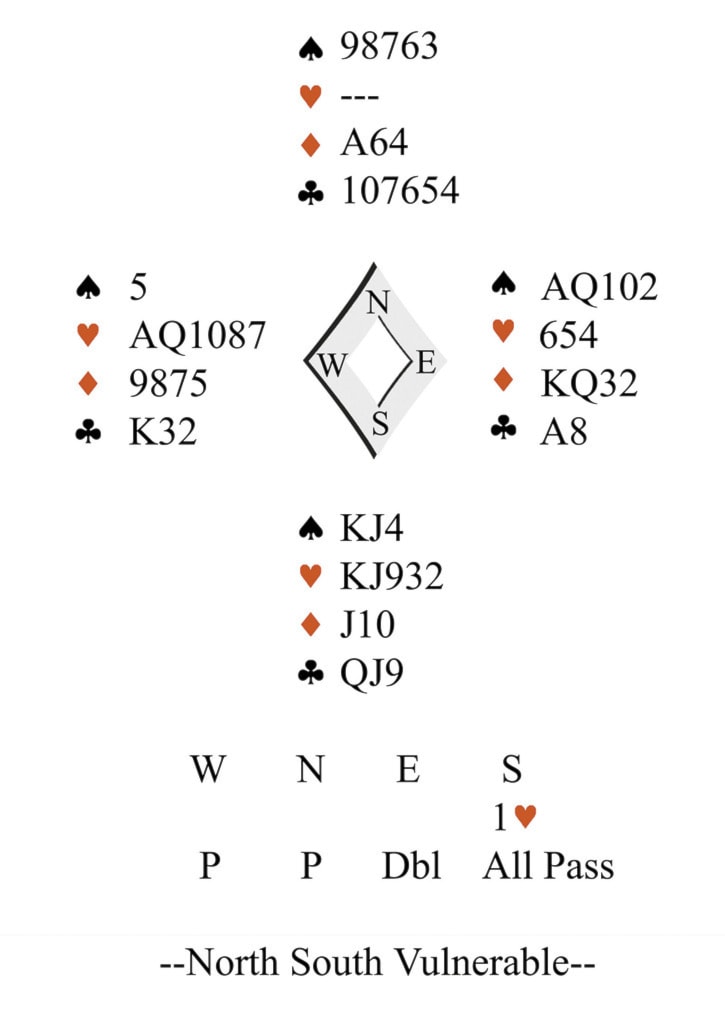Takeout doubles are usually doubles at the one or two-level, higher if opponents pre-empt. The following doubles are for penalty:
1. Doubles made by doubling over and not doubling under; 2. A double made by your partner when you have already told him your hand (1NT or a pre-empt does this); 3. A double after one’s partner has already answered (by a bid not a pass) a takeout double; 4. A double made when the partnership knows they have the balance of power; 5. A double made after the partnership has agreed on a suit; 6. Any takeout double may be passed not for lack of a better bid but for penalty (conversion). 7. Any double made after a takeout double has been converted to penalty (passed); and 8. any double after the partnership makes a redouble.
This week’s column is an example of 6.
The bidding: South with 12 points opens one heart. This is an ugly opener and could have been passed. It has all four jacks and a queen making it a soft opener. It does not have a rebid, and it is often good to get a heart bid in at a low level before the opponents find spades.
West and North pass, and East, with four spades and four diamonds, doubles for takeout. West knows that in addition to a few trump tricks, a combined 22 points are needed to defeat a one-level contract. West knows they have a potential of five trump tricks and at least 21 points so he leaves the double in.
West’s first pass is called a trap pass because he has length in opponent’s suit and hopes that his partner doubles for takeout. Here, East did exactly that, and West converted the takeout double to penalty. West could have overcalled one spade, if he had AQ1087 in spades and a singleton heart. However, it is best to stay out of the auction and wait to see what partner can do.
The contract: One heart doubled by South
The opening lead: The five of spades West leads partner’s suit. A double of one heart for takeout shows spades which is a good place to start.
The play: East wins the ace of spades and returns the two to be ruffed. The two asks for a club return after partner ruffs. West ruffs a spade and returns a club to partner’s ace. West gets another spade ruff and cashes the king of clubs. East gets a club ruff. At this point, declarer is known to be 3-5-2-3. Another spade ruff at this point will allow declarer to pitch a losing diamond. East plays the king of diamonds which dummy wins with the ace. Declarer plays a club for a discard, but East ruffs with a small heart. It does not matter what declarer does now. West will get all of its trump and will be able to exit in diamonds to avoid any endplay.
East and West will get ten tricks setting the contract by four.
The result: One heart doubled down four for -1100.
Note: There is a bid called the SOS redouble that North should have used here. If partner opens one hearts and West doubles, a redouble implies no fit and shows 10 or more points. However, if a takeout double gets converted, a redouble now tells partner to run. North should redouble because he knows that he and East who made a takeout are short in hearts. Here South will run to clubs because spades is East’s implied suit. Can you see how two clubs will make?
On May 8 at 7 p.m., I will have 15 boards of instructed duplicate. All the boards will be made with a teaching purpose, such as transfers or Blackwood, in mind. Hand records will be given to emphasize the concepts. The fee is $5 a session, and the frequency of this event will depend on response. If interested, call 250-368-3527 or email wt.watson@yahoo.ca.
